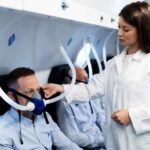Have you ever wondered how far cancer treatment has come in the last decade? From long hospital stays to personalised care plans that target the disease directly, oncology has entered a new era of possibility. Today, modern science is transforming how patients live, recover, and thrive after diagnosis.
This article will explore the latest breakthroughs in oncology treatments that improve survival rates, reduce side effects, and bring real comfort and hope to patients. By the end, you will understand how these innovations are reshaping cancer care and giving patients stronger reasons to believe in better outcomes.
How Modern Oncology Treatments Transform Survival Rates
Cancer was once seen as a disease with few options, but today’s treatments tell a different story. Advances in targeted therapy, immunotherapy, and precision medicine have changed how doctors fight cancer.
Instead of treating all patients the same way, oncologists now tailor therapies to the exact genetic and molecular profile of the tumour. This approach increases effectiveness and lowers harm to healthy cells.
Immunotherapy, for instance, trains the immune system to identify and attack cancer cells on its own. Drugs such as checkpoint inhibitors help the body’s natural defences stay alert, leading to longer-lasting responses.
Many patients who once faced limited options are now living years beyond their original prognosis. Survival rates for certain cancers like melanoma, lung, and leukaemia have risen notably, proving that precision-based treatments are rewriting the story of cancer recovery.
What makes this progress remarkable is how science focuses not only on killing cancer but on keeping patients strong. This shift has helped thousands live longer while maintaining better energy and quality of life.
Personalised Medicine Is Changing Every Patient’s Story
Every person’s cancer is unique, and now, treatment can be just as personal. In precision oncology, doctors use genetic testing to understand what mutations drive a patient’s cancer.
This knowledge allows them to choose drugs that specifically block those changes while sparing healthy cells. It means fewer side effects and better results.
For example, if a patient’s tumour has a gene that causes cells to grow too fast, the doctor can use a medication designed to stop that process. The result is more targeted control and fewer harsh reactions compared to traditional chemotherapy.
This approach also makes it easier to adjust treatment as the disease evolves. If a tumour changes over time, doctors can test again and adapt the plan. It’s an ongoing partnership between patient, doctor, and science-one that focuses on precision instead of trial and error.
Personalised medicine has brought new confidence to patients who used to feel lost in the complexity of cancer care. They now know that their treatment is designed for them and no one else.
How Immunotherapy Turns The Body Into A Cancer Fighter
One of the biggest revolutions in oncology is immunotherapy. Unlike chemotherapy, which attacks cells directly, immunotherapy gives the immune system tools to recognise and fight cancer on its own. This method helps the body become an active participant in the healing process.
Checkpoint inhibitors, CAR-T cell therapy, and cancer vaccines are some of the most successful immunotherapy methods. Checkpoint inhibitors remove the “brakes” that cancer places on immune cells. CAR-T therapy modifies a patient’s own cells in the lab, reprogramming them to detect and destroy tumours once infused back into the body.
While these treatments sound complex, their results are deeply human. Patients who once ran out of options are seeing cancers shrink or disappear entirely.
In some cases, immunotherapy has turned once-fatal diseases into manageable conditions, allowing patients to return to normal routines and even long-term remission. The idea that the body itself can become the greatest weapon against cancer has transformed both medical practice and patient morale.
Targeted Therapy Brings Precision To Every Step
Targeted therapy works like a guided missile. It aims at specific molecules that cancer cells need to grow and spread. Unlike chemotherapy, which affects both cancerous and healthy cells, targeted therapy strikes only where it’s needed.
Drugs in this class identify proteins or genes that act as “drivers” of cancer and block their signals. This prevents tumour cells from multiplying and sometimes forces them to die. Because it is so specific, patients often experience fewer side effects, such as hair loss or nausea.
Another advantage of targeted therapy is that it can be combined with other treatments. When used with immunotherapy or radiation, it increases overall success rates.
Research has also shown that some targeted therapies can cross barriers in the brain, helping treat cancers that were once difficult to reach. The result is a balanced approach where precision meets compassion, giving patients more control over their treatment journey.
How Technology Supports Better Cancer Outcomes
New technology is making oncology smarter and more responsive. Artificial intelligence helps doctors study scans, genetic data, and clinical history to predict which treatments will work best for each patient. Machine learning tools can identify patterns that humans might miss, saving time and guiding better decisions.
Radiation therapy has also advanced. Modern machines now use imaging in real-time to target tumours while protecting healthy tissue. Robotic surgery allows doctors to remove cancer more accurately, leading to faster recovery times and fewer complications.
Even wearable devices are finding a place in cancer care. These tools track a patient’s health at home, recording sleep, heart rate, and side effects.
This data helps doctors monitor progress without requiring long hospital stays. Every piece of technology is built with one goal in mind-to make treatment faster, safer, and more effective.
The Role Of Patient-Derived Xenograft (PDX) Models In Research
Behind every modern treatment lies years of research. One of the most important tools helping scientists develop new therapies is patient-derived xenograft (PDX) models. These models use real human tumour samples implanted into mice to study how cancer behaves and responds to different drugs.
What makes this method powerful is its accuracy. Because PDX models come from actual patients, they mimic the human tumour environment far better than older lab techniques. Researchers can test treatments before trying them in clinical trials, improving the chances of success and safety.
This process helps doctors predict how a specific type of tumour might react to a new drug. It also speeds up the discovery of personalised medicines that match each patient’s genetic profile. Thanks to PDX models, many new cancer drugs are reaching patients faster and with higher effectiveness.
Reducing Side Effects While Improving Quality Of Life
Modern oncology no longer focuses only on survival-it focuses on living well. Today’s treatments are designed to minimise side effects while still being powerful against cancer.
For instance, targeted therapies reduce the damage to healthy tissues, lowering fatigue and nausea. Immunotherapies often bring milder long-term effects than traditional chemotherapy.
Supportive care has also grown stronger. Nutrition plans, physical therapy, and emotional support help patients stay healthy throughout treatment. Even new drug combinations are tested with comfort in mind.
Doctors now measure success not only by how long patients live but by how well they live. Being able to spend more time with family, return to work, or enjoy simple routines makes the fight against cancer more than just a medical process-it becomes a personal victory.
Support Systems That Empower Healing
Beyond medicine, emotional and social support play a major role in recovery. Hospitals are building programs that connect patients with counsellors, peer groups, and wellness coaches. These networks remind patients they are not alone and that healing involves both the mind and the body.
Care teams now include dietitians, therapists, and exercise specialists who help manage fatigue and stress. Many cancer centres also use digital platforms to connect patients with resources from home, offering guidance on sleep, nutrition, and emotional care.
This combination of modern science and human compassion strengthens every treatment. When patients feel supported, their outlook improves-and that emotional balance often enhances their physical recovery too.
The Future Of Oncology Looks Brighter Than Ever
Every discovery in oncology builds a bridge toward a future where cancer becomes more manageable and less frightening. Clinical trials worldwide are testing next-generation drug combining genetics, AI, and nanotechnology to develop even more accurate treatments. Early detection is improving through advanced blood tests that can spot cancer before symptoms appear.
Meanwhile, telemedicine makes it easier for patients in remote areas to reach top specialists without long travel times. These innovations bring hope to families who once felt left behind by geography or cost. As research expands and treatments become more precise, the dream of curing cancer-or at least turning it into a long-term, livable condition-feels closer than ever.
A New Era Of Cancer Care Is Here
The story of cancer treatment is no longer only about survival-it is about renewal, confidence, and quality of life. Breakthrough oncology treatments are not just improving statistics; they are transforming everyday lives. From precision medicine and immunotherapy to advanced technology and compassionate support, patients now have more tools and more hope than ever before.
Cancer care has moved beyond a one-size-fits-all approach. It’s now about empowering each patient with personalised care that works with their body and their story. Science, empathy, and innovation have come together to create a future where better outcomes are possible for everyone.
Did this guide help you? Browse the rest of this section for more advice on a variety of topics.










